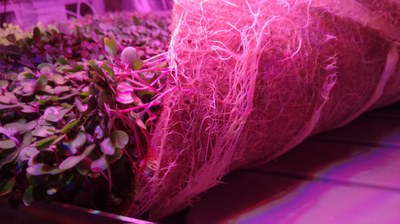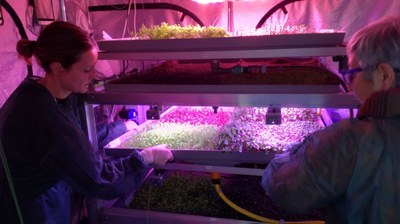Space: "Martian garden" made in Italy for future missions to the Red Planet
25/1/2018
 It’s all Italian the Martian garden for the international expenditure Amadee-18, which engages 5 astronauts for four weeks in Oman in February preparing future missions to Mars. Developed by ASI, ENEA and the University of Milan as part of a plant biology experiment called HortExtreme, the garden is a 4 m2 containment system in which four types of microgreens - including red cabbage and radishes - will be grown, selected because of their short vital cycle (about fifteen days) and correct nutritional intake, to provide the crew with high-quality food thanks to a soil-less cultivation method where water is recirculated and recycled (hydroponic system) without the use of pesticides and agrochemicals.
It’s all Italian the Martian garden for the international expenditure Amadee-18, which engages 5 astronauts for four weeks in Oman in February preparing future missions to Mars. Developed by ASI, ENEA and the University of Milan as part of a plant biology experiment called HortExtreme, the garden is a 4 m2 containment system in which four types of microgreens - including red cabbage and radishes - will be grown, selected because of their short vital cycle (about fifteen days) and correct nutritional intake, to provide the crew with high-quality food thanks to a soil-less cultivation method where water is recirculated and recycled (hydroponic system) without the use of pesticides and agrochemicals.
The prototype of the martian garden was officially submitted to the Austrian Space Forum (OeWF), coordinator of the mission Amadee-18, with the participation of the Oman Astronomical Society and other international research organizations in the fields of aerospace, engineering and human space exploration. In early January it was sent from Innsbruck to the base camp set up in Oman where, in the hands of the astronaut Claudia Kobald, in February it's due to start its simulation mission, useful for future crewed missions to the planet Mars.
“These are crucial issues for expenditures with the purpose of human exploration and with a huge potential of application to issues like environmental sustainability and energy efficiency on earth”, Gabriele Mascetti, Head of the Human Flight and Microgravity Unit of the Italian Space Agency (ASI), said. "Our commitment to research on bioregenerative life support systems will provide us with useful information on our path to future human exploration missions on the planet Mars. The agreement with the Austrian Space Forum was made possible thanks to the support and collaboration of the Italian Mars Society”, Mascetti concluded.
The Italian project HortExtreme was selected to be part of the Mars analog mission Amadee-18 for its capacity of developing closed ecosystems for the in situ production of the resources necessary to future human missions in the solar System.
 “The hydroponic cultivation system we developed is of the ebb and flood type, in which plants are grown in a large tray containing substrate, placed in way so that plants may receive light and food at regular intervals, modulated by ad hoc sensors operating in real time” Eugenio Benvenuto, Head of the ENEA Biotechnologies Laboratory pointed out. “Thanks to cutting edge instrumentation and microcameras pointed at the plants during the entire mission, both astronauts and researchers and technicians at our laboratory will be able to daily monitor energy consumption and plant physiology parameters of the Martian garden, with the objective of demonstrating the productivity of the ecosystem in the extreme conditions foreseen by the simulation mission. A project paving the way to new possibilities of application for a nutrition combining high quality with high yield” Benvenuto concluded.
“The hydroponic cultivation system we developed is of the ebb and flood type, in which plants are grown in a large tray containing substrate, placed in way so that plants may receive light and food at regular intervals, modulated by ad hoc sensors operating in real time” Eugenio Benvenuto, Head of the ENEA Biotechnologies Laboratory pointed out. “Thanks to cutting edge instrumentation and microcameras pointed at the plants during the entire mission, both astronauts and researchers and technicians at our laboratory will be able to daily monitor energy consumption and plant physiology parameters of the Martian garden, with the objective of demonstrating the productivity of the ecosystem in the extreme conditions foreseen by the simulation mission. A project paving the way to new possibilities of application for a nutrition combining high quality with high yield” Benvenuto concluded.
“Thanks to the experience gained conducting scientific experiments in extreme and hostile environments and the necessity for surviving systems both for humans and instruments, we will contribute to the installation of hydroponic cultivation systems” Cavaliere and Potenza of the Physics Department of the Milan University, involved for many years in the implementation of experimental activities in Antarctica, the Alps and in Space, pointed out. “This is the natural prosecution of the development of residential modules capable of withstanding temperatures of up -80°, winds over 100 km/h, which will bring to the development of inflatable greenhouses equipped with an advanced sensoristics network to measure all the parameters needed for human and vegetal life on Mars”. The development of the inflatable modules was carried out from the beginning in collaboration with Plasteco in Senago.
Now at its 12th edition, Amadee-18 aims at studying and validating the equipment which could be employed in future human missions on Mars, providing platforms for geophysics techniques and the identification of traces of life, as well as assessing the mobility of a rover on a terrain resembling that of Mars. That’s not all: Amadee18 is a crucial step in the study of the site chosen for the mission as a model of extreme environment as well as for promoting research in the space sector and stimulating the interest for planetary sciences.
19 experiments proposed by institutions from all over the world will be conducted on the themes of geosciences, robotics, engineering, with projects on hardware, software and virtual reality, planetary surface operations, human factors, experiments on social sciences and humanities and life sciences, including astrobiology. But also projects on the most operational aspects of the mission, equipment and spacesuits, robotic systems, as well as flight planning and long distance work flows for complex missions, including communication delays.
Representing Italy in the international mission to Mars in addition to HortExtreme, three projects in the fields of virtual reality and geosciences developed by the Italian Space Agency itself, the Perugia University and the Organisation Mars Planet. The Dhofar desert - located in the same Governorate, the largest of the Oman Sultanate - was chosen as the site of the mission because of its characteristics which makes it similar to the Red Planet, such as the sedimentary structures dating back to the Paleocene and Eocene, salt domes of the South Oman Salt Basin and ancient river beds, sand and rocky surfaces with a great variability in inclination. In Oman the climate is tropical desert with temperature in February typically ranging between 16 and 27 °C and less than 10 mm of rainfalls.
For more information please contact:
Eugenio Benvenuto, ENEA - Head Biotechnologies Laboratories, eugenio.benvenuto@enea.it
